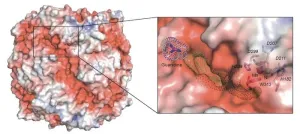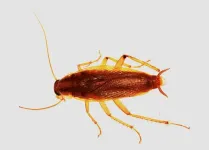(Press-News.org) An international research team led by the Centre for Microbiology and Environmental Systems Science (CeMESS) at the University of Vienna has discovered that comammox bacteria, first identified by them in 2015, can grow using guanidine, a nitrogen-rich organic compound, as their sole energy and nitrogen source. This unique ability opens new avenues for targeted cultivation of these enigmatic microbes and could also provide a key to reducing agricultural nitrous oxide emissions. The research findings were recently published as an article in the prestigious journal Nature.
Nitrification, the conversion of ammonia via nitrite to nitrate, is carried out by specialized microorganisms called nitrifiers. This process is extremely important for the global biogeochemical nitrogen cycle in virtually all ecosystems, but it plays an ambivalent role in global change. On one hand, nitrification contributes to the emission of the potent greenhouse gas and ozone-depleting substance nitrous oxide and leads to massive fertilizer losses in agriculture, resulting in the eutrophication of water bodies. On the other hand, nitrification is indispensable as a biological purification step for nutrient removal in wastewater treatment plants, thus protecting water bodies from excessive nitrogen input from wastewater. The study authors have now found a way that may promote nitrifiers in the environment that emit less nitrous oxide.
"Green" Nitrifiers
Comammox bacteria are considered "green" nitrifiers because, unlike many other nitrifiers, they produce only small amounts of nitrous oxide as a byproduct of their metabolism and efficiently remove nitrogen compounds from wastewater in treatment plants. Since the discovery of nitrifiers in the 19th century, it was assumed that these microorganisms could only respire ammonia and urea. In 2015, the research groups led by Michael Wagner and Holger Daims demonstrated that some nitrifiers could also use the chemically unstable cyanate for their energy metabolism. "In the recently published paper, our team has now shown that comammox bacteria can also grow with the unconventional substrate guanidine," explains Marton Palatinszky, the study's first author. "The comammox bacteria use a transporter and an enzyme, structurally and functionally characterized in detail by us, which allows them to produce ammonium from guanidine in a highly energy-efficient manner within the cell."
Guanidine is a metabolic product of microorganisms and plants. Little is known about its role in human and animal metabolism. It is formed in soils during the degradation of synthetic fertilizer additives and in wastewater during the breakdown of the commonly used drug metformin. However, little is known about the distribution and further processing of guanidine in the environment. The international research team, including microbiologists from the Helmholtz Centre for Environmental Research in Leipzig; Germany and Aalborg University in Denmark, demonstrated that guanidine is present not only in human urine but also in livestock excreta and that comammox bacteria utilize guanidine in wastewater treatment plants. They also showed that guanidine is metabolized by nitrifiers in agricultural soils.
New Opportunities for Cultivation and Nitrous Oxide Reduction
The Vienna microbiologists are now attempting to enrich and isolate the widespread comammox bacteria from environmental samples using guanidine, as only one strain is currently available in pure culture worldwide. "This seems particularly promising as none of the other nitrifier strains we tested could grow with guanidine as the sole energy and nitrogen source," explains Katharina Kitzinger, a Senior Scientist at CeMESS. The team also wants to investigate whether adding guanidine to agricultural fertilizers could increase the abundance of comammox bacteria in arable soils, thereby reducing agricultural nitrous oxide emissions.
"This work would not have been possible without the close collaboration of many researchers involved in the 'Microbiomes Drive Planetary Health' Cluster of Excellence, launched in 2023. We extend our sincere thanks to the Austrian Science Fund (FWF) for this special support," says study leader Michael Wagner.
END
Newly discovered ability of comammox bacteria could help reduce nitrous oxide emissions in agriculture
Research team identifies unconventional energy source for recently discovered "green" nitrifying bacteria
2024-08-14
ELSE PRESS RELEASES FROM THIS DATE:
Cybersecurity flaws could derail high-profile cycling races
2024-08-14
High-end bicycles used for high-profile road races such as the Tour de France are vulnerable to cybersecurity attacks targeting the bike’s wireless gear shifting system.
In recent years, bicycle manufacturers have adopted wireless gear-shifting technology, which gives riders better control over changing gears. The technology is not vulnerable to the physical issues that plague mechanical systems. However, the way the wireless systems were built created critical cybersecurity vulnerabilities, which a team of computer scientists from the University of California ...
How bread dough gave rise to civilization
2024-08-14
A major international study has explained how bread wheat helped to transform the ancient world on its path to becoming the iconic crop that today sustains a global population of eight billion.
“Our findings shed new light on an iconic event in our civilisation that created a new kind of agriculture and allowed humans to settle down and form societies,” said Professor Brande Wulff, a wheat researcher at KAUST (King Abdullah University of Science and Technology) and one of the lead ...
Revealing the mysteries within microbial genomes
2024-08-14
A new technique developed at Lawrence Berkeley National Laboratory (Berkeley Lab) will make it much easier for researchers to discover the traits or activities encoded by genes of unknown function in microbes, a key step toward understanding the roles and impact of individual species.
The approach, called barcoded overexpression bacterial shotgun library sequencing, or Boba-seq, is described in a paper published August 5 in Nature Communications.
“There is so much genetic dark matter – ...
Consumer-grade insecticide sprays fail to control cockroaches, study shows
2024-08-14
Annapolis, MD; August 14, 2024—A common variety of consumer insecticide sprays is mostly ineffective and of "little to no value" in eliminating cockroach infestations, a new study shows.
Residual insecticides are designed to be sprayed on surfaces where cockroaches are likely to appear, exposing them to the toxic ingredient when they move across the surface later. But laboratory testing by researchers at the University of Kentucky and Auburn University shows that the residues have little effect on German cockroaches (Blattella germanica), ...
Children’s Hospital of Philadelphia researchers find possible inaccuracies in crash-reported child passenger injuries
2024-08-14
Philadelphia, August 14, 2024 – Researchers from the Center for Injury Research and Prevention (CIRP) at Children’s Hospital of Philadelphia (CHOP) found discrepancies between crash reports and hospital data that might paint an incomplete or inaccurate picture of how crashes impact the safety of child passengers. Enhancing the quality of injury data reported in crash reports can aid researchers in assessing the effectiveness of various transportation safety strategies for children. The findings were recently published by ...
Ontario Institute for Cancer Research announces awards for eight research teams developing innovative ways to diagnose and treat cancer
2024-08-14
August 14, 2024, TORONTO — A new round of awards from the Ontario Institute for Cancer Research (OICR) will jumpstart eight promising studies that could change how cancers are diagnosed and treated.
OICR announced the results of its Pre-Clinical Acceleration Team Awards — part of the Institute’s Clinical Translational Pathway, which helps advance new discoveries so they can benefit people affected by cancer.
The winning research teams are based across Ontario and are tackling some of the most common and hardest to treat cancers. They are developing solutions to find cancer earlier, diagnose it more ...
People with COPD, asthma have higher risk of health problems from increased wildfire activity, smoke
2024-08-14
MIAMI (August 14, 2024) – Communities impacted by increased wildfire activity and smoke can use a population health-based action plan to help alleviate health risks, particularly for those with chronic obstructive pulmonary disease (COPD) and asthma, according to a new perspective article. The article is published in the July 2024 issue of Chronic Obstructive Pulmonary Diseases: Journal of the COPD Foundation, a peer-reviewed, open-access journal.
COPD is an inflammatory lung disease, comprising several conditions, ...
Early life exposure to common chemical permanently disrupts gut microbiome
2024-08-14
UNIVERSITY PARK, Pa. — Early life exposure to ‘forever chemicals’ in the environment permanently disrupts the gut microbiome in mice, contributing to the development of metabolic disease in later life, according to new research led by Penn State. The results, published today (Aug. 14) in the journal Environmental Health Perspectives, suggest that human exposure to these chemicals during early childhood may be contributing to the recent epidemic of metabolic disorders, including obesity and type 2 diabetes among adults.
The researchers focused specifically on 2,3,7,8-tetrachlorodibenzofuran ...
Rocks collected on Mars hold key to water and perhaps life on the planet. Bring them back to Earth.
2024-08-14
Over the course of nearly five months in 2022, NASA's Perseverance rover collected rock samples from Mars that could rewrite the history of water on the Red Planet and even contain evidence for past life on Mars.
But the information they contain can't be extracted without more detailed analysis on Earth, which requires a new mission to the planet to retrieve the samples and bring them back. Scientists hope to have the samples on Earth by 2033, though NASA's sample return mission may be delayed.
"These samples are the reason why our mission was flown," said paper ...
Nighttime light data shows inequities in restoring power after Hurricane Michael
2024-08-14
Among the many devasting impacts in the aftermath of a hurricane are power outages, which can take days or even weeks to restore. Communities grappling with the loss of electricity may encounter obstacles in accessing vital services, including food, fuel and health care.
In 2018, Hurricane Michael, a Category 5 storm, wreaked havoc in Florida as it made landfall in the United States. It was strongest recorded to hit the Florida Panhandle with winds of nearly 161 miles per hour and storm surge reaching heights ...
LAST 30 PRESS RELEASES:
Practical education: Clinical scenario-based program development
The impact of family dynamics on eating behaviour – how going home for Christmas can change how you eat
Tracing the quick synthesis of an industrially important catalyst
New software sheds light on cancer’s hidden genetic networks
UT Health San Antonio awarded $3 million in CPRIT grants to bolster cancer research and prevention efforts in South Texas
Third symposium spotlights global challenge of new contaminants in China’s fight against pollution
From straw to soil harmony: International team reveals how biochar supercharges carbon-smart farming
Myeloma: How AI is redrawing the map of cancer care
Manhattan E. Charurat, Ph.D., MHS invested as the Homer and Martha Gudelsky Distinguished Professor in Medicine at the University of Maryland School of Medicine
Insilico Medicine’s Pharma.AI Q4 Winter Launch Recap: Revolutionizing drug discovery with cutting-edge AI innovations, accelerating the path to pharmaceutical superintelligence
Nanoplastics have diet-dependent impacts on digestive system health
Brain neuron death occurs throughout life and increases with age, a natural human protein drug may halt neuron death in Alzheimer’s disease
SPIE and CLP announce the recipients of the 2025 Advanced Photonics Young Innovator Award
Lessons from the Caldor Fire’s Christmas Valley ‘Miracle’
Ant societies rose by trading individual protection for collective power
Research reveals how ancient viral DNA shapes early embryonic development
A molecular gatekeeper that controls protein synthesis
New ‘cloaking device’ concept to shield sensitive tech from magnetic fields
Researchers show impact of mountain building and climate change on alpine biodiversity
Study models the transition from Neanderthals to modern humans in Europe
University of Phoenix College of Doctoral Studies releases white paper on AI-driven skilling to reduce burnout and restore worker autonomy
AIs fail at the game of visual “telephone”
The levers for a sustainable food system
Potential changes in US homelessness by ending federal support for housing first programs
Vulnerability of large language models to prompt injection when providing medical advice
Researchers develop new system for high-energy-density, long-life, multi-electron transfer bromine-based flow batteries
Ending federal support for housing first programs could increase U.S. homelessness by 5% in one year, new JAMA study finds
New research uncovers molecular ‘safety switch’ shielding cancers from immune attack
Bacteria resisting viral infection can still sink carbon to ocean floor
Younger biological age may increase depression risk in older women during COVID-19
[Press-News.org] Newly discovered ability of comammox bacteria could help reduce nitrous oxide emissions in agricultureResearch team identifies unconventional energy source for recently discovered "green" nitrifying bacteria






